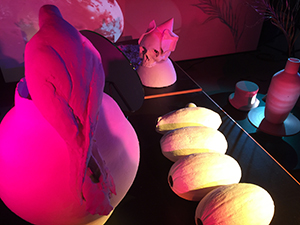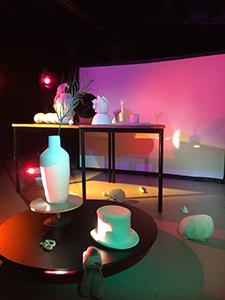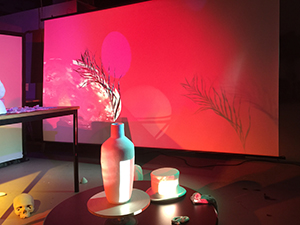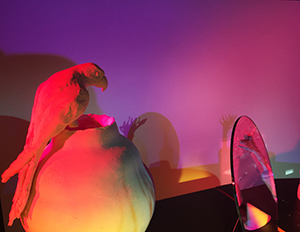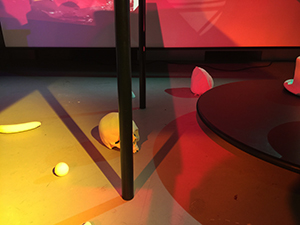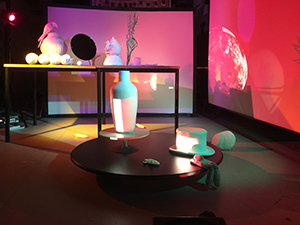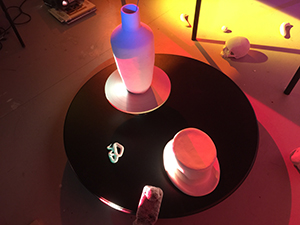
Alien Phenomenology and the Porcelain Workshop of Things – the fragility that forms in nature and culture
2019. Immersive sculptural installation consisting of cast and hand-built, unfired porcelain objects, raw clay, screen walls, slide projections, stage lights with color filters, tables, appropriated objects. Dimensions variable. A study of weird realism striving to develop an ecology of practice that engages with the power of the allure. Installation view, Werkdiskurs, ZHdK.
Installation and detail views of Alien Phenomenology and the Porcelain Workshop of Things – the fragility that forms in nature and culture. Photos courtesy of the artist
Alien Phenomenology and the Porcelain Workshop of Things – the fragility that forms in nature and culture
The installation displays the relation between material practices, the archeology of knowledge – which is also an archeology of objects – and imagination as speculative possibilities not only of the subject but of the objects. In the interplay of light and shadow on surfaces, they fabulate and tell their own stories. Objects communicate between themselves, as do levels of reality. The use of metaphors leads to unexpected affinities between the objects. The work employs (dis-)embodied methods of estrangement, displacement and alluring.
The relation between three-dimensional object and two-dimensional image is emphasized in the interplay between the objects and their shadows, as obscurity and darkness are taken as a pre-existing condition of reality, or dark precursor. The light illuminating the objects is diffracted by selected filters to underline the artificiality of the constructed environment and manipulate perceptions reflecting the notion of virtuality. The latter is not a prerogative of VR technology, but extends to the (dark) allure and the phenomena of reality itself. This includes the reality of the art work, whose artificiality as a constructed-illusive reality – but real nonetheless – is emphasized. The work experiments with re-organizing the relation between display, the objects and the viewers, in reference to some installative works of institutional critique by Marcel Broodthaers.
The installation can be conceived of as a perceptual apparatus. It raises the question of “What is it like to be a thing?” (referring to Thomas Nagel’s essay “What is it like to be a bat?”) to abandon anthropocentric attitudes. It is not merely informed by a theory of object-object relations taking the place of subject-subject or subject-object relations. Its strategy is to release the objects like ghosts. It is a site-specific and also medium-specific process which is itself a metaphor that leads to unexpected affinities between objects – a way to grasp alien objects’ perceptions of one another. It is a dramatization of objects, a play between them, not with them. A spatial dramaticule screaming and laughing, but without irony – not a comedy, nor a tragedy, but a dramaticule, a term borrowed from Samuel Beckett.
The objects express likeness and withdrawal. They are not objects of daily life, but their copies, or prototypes. The project stresses the space of negativity, not as something negative, but as the dark unfolding of an object’s hidden essence that shows its potentiality to abscond representation. The negative or virtual space is a process of throwing distinctions and likenesses, which is a performative movement between essence and appearance in which the object can be ontologically riven. The practices of absconding can be equally called darkening, clothing, tinting, flowering, withdrawing, a thinging of the thing – or just a fling, which is like an erotic flirt between the things themselves, the sensual side of the object that uncovers its essence while blurring it all at once.
The inherent affinity between aesthetics and speculation is used as a tool. Speculation insists on the word for itself. (a reference to Alfred North Whitehead and Bertrand Russell, who look at speculation in science as the imaginative hypotheses that interact with observations and facts). It grants objects their independence. Speculation and aesthetic practices (viewing and judgment, taste) bring the two worlds together, human and non-human, to create new, unexpected commonalities.

